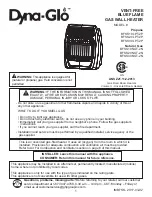
Tire Safety Information
1.5.4. S
TEPS FOR
M
AINTAINING
P
ROPER
T
IRE
P
RESSURE
Step 1: Locate the recommended tire pressure on the vehicle's tire information placard, certification
label, or in the owner's manual.
Step 2: Record the tire pressure of all tires.
Step 3: If the tire pressure is too high in any of the tires, slowly release air by gently pressing on the
tire valve stem with the edge of your tire gauge until you get to the correct pressure.
Step 4: If the tire pressure is too low, note the difference between the measured tire pressure and the
correct tire pressure. These "missing" pounds of pressure are what you will need to add.
Step 5: At a service station, add the missing pounds of air pressure to each tire that is underinflated.
Step 6: Check all the tires to make sure they have the same air pressure (except in cases in which the
front and rear tires are supposed to have different amounts of pressure).
If you have been driving your vehicle and think that a tire is underinflated, fill it to the recommended cold
inflation pressure indicated on your vehicle's tire information placard or certification label. While your tire may
still be slightly underinflated due to the extra pounds of pressure in the warm tire, it is safer to drive with air
pressure that is slightly lower than the vehicle manufacturer's recommended cold inflation pressure than to
drive with a significantly underinflated tire. Since this is a temporary fix, don't forget to recheck and adjust the
tire's pressure when you can obtain a cold reading.
1.5.5. T
IRE
S
IZE
To maintain tire safety, purchase new tires that are the same size as the vehicle's original tires or another size
recommended by the manufacturer. Look at the tire information placard, the owner's manual, or the sidewall of
the tire you are replacing to find this information. If you have any doubt about the correct size to choose,
consult with the tire dealer.
1.5.6. T
IRE
T
READ
The tire tread provides the gripping action and traction that prevent your vehicle from slipping or sliding,
especially when the road is wet or icy. In general, tires are not safe and should be replaced when the tread is
worn down to 1/16 of an inch. Tires have built-in treadwear indicators that let you know when it is time to
replace your tires. These indicators are raised sections spaced intermittently in the bottom of the tread
grooves. When they appear "even" with the outside of the tread, it is time to replace your tires. Another method
for checking tread depth is to place a penny in the tread with Lincoln's head upside down and facing you. If
you can see the top of Lincoln's head, you are ready for new tires.
1.5.7. T
IRE
B
ALANCE AND
W
HEEL
A
LIGNMENT
To avoid vibration or shaking of the vehicle when a tire rotates, the tire must be properly balanced. This
balance is achieved by positioning weights on the wheel to counterbalance heavy spots on the wheel-and-tire
assembly. A wheel alignment adjusts the angles of the wheels so that they are positioned correctly relative to
the vehicle's frame. This adjustment maximizes the life of your tires. These adjustments require special
equipment and should be performed by a qualified technician.
1.5.8. T
IRE
R
EPAIR
The proper repair of a punctured tire requires a plug for the hole and a patch for the area inside the tire that
surrounds the puncture hole. Punctures through the tread can be repaired if they are not too large, but
punctures to the sidewall should not be repaired. Tires must be removed from the rim to be properly inspected
before being plugged and patched.
1.5.9. T
IRE
F
UNDAMENTALS
Federal law requires tire manufacturers to place standardized information on the sidewall of all tires. This
information identifies and describes the fundamental characteristics of the tire and also provides a tire
identification number for safety standard certification and in case of a recall.
Summary of Contents for 5000620172
Page 19: ...E 1100 Safety Information wc_si000628gb fm 19 Notes ...
Page 20: ...Labels E 1100 20 wc_si000629gb fm 2 Labels 2 1 Label Locations wc_gr009588 ...
Page 105: ...ghi_tx001153gb fm 105 E 1100 Maintenance ...
Page 122: ...Technical Data E 1100 122 wc_td000476gb fm 10 5 Dimensions cm in wc_gr008706 ...
Page 133: ...wc_tx001673gb fm 133 Fuji Temperature Controller ...
Page 134: ...wc_tx001673gb fm 134 Fuji Temperature Controller ...
Page 151: ...E 1100 Schematics wc_tx001908gb fm 151 11 3 Burner System Circuit ...
Page 152: ...Schematics E 1100 152 wc_tx001908gb fm 11 4 Circulation System Circuit ghi_gr005662 ...
Page 153: ...E 1100 Schematics wc_tx001908gb fm 153 11 5 Rewind System Circuit ...
Page 158: ...Schematics E 1100 158 wc_tx001908gb fm 11 10 Genset DC Wiring Diagram ...
Page 160: ......
Page 161: ......
















































